On the Art of Occupying Spaces and Curating Film Programmes
Cinema Commons #1
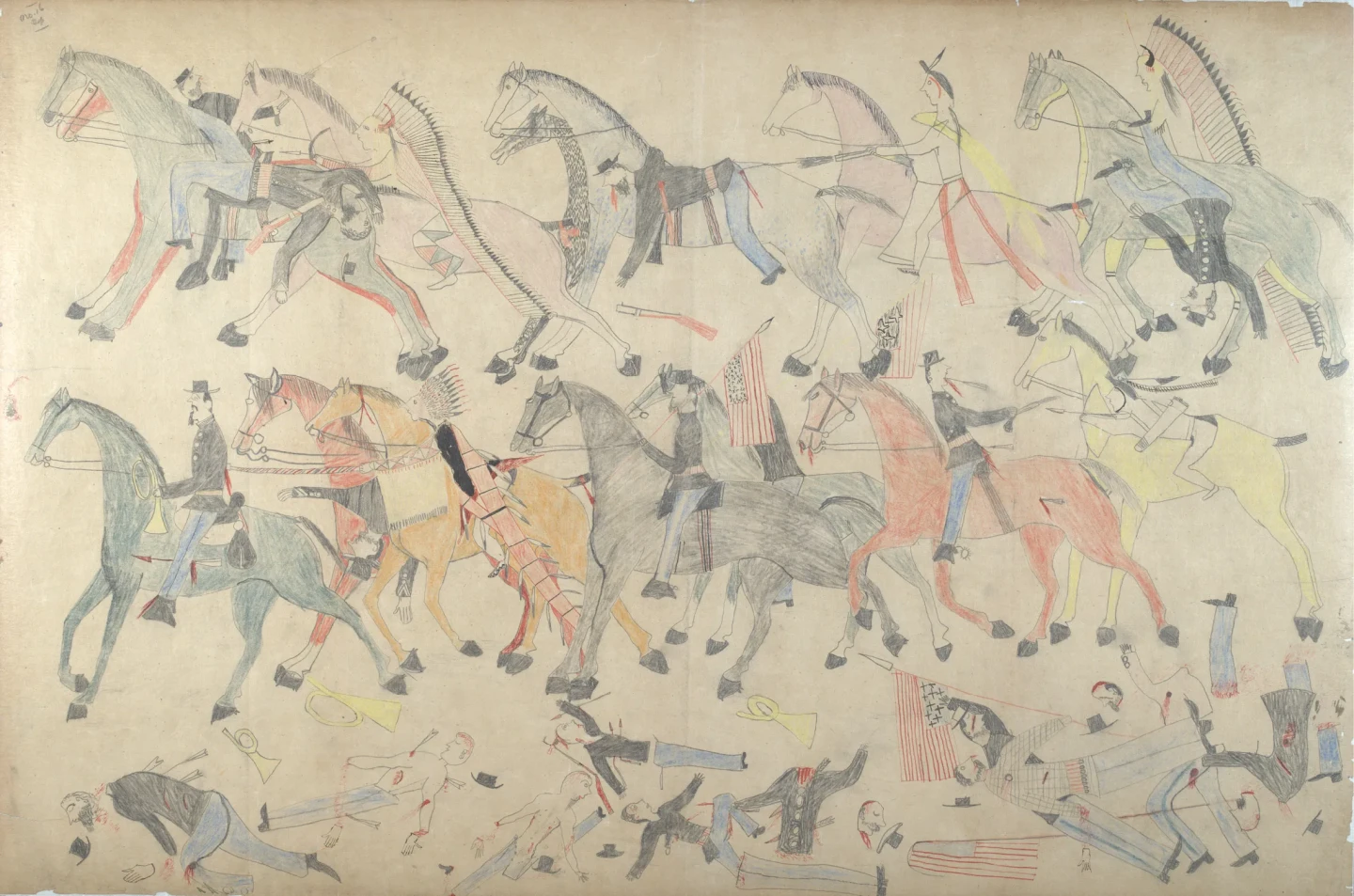
Red Horse, Red Horse’s depiction of the destruction of Custer’s command at the Battle of the Little Bighorn, 1881
Graphite, coloured in pencil and ink
Held on 23, 24, 25, 30, 31 Oct 2025
On the Art of Occupying Spaces and Curating Film Programmes is a film programme overseen by Miriam Martín and Ana Useros, and the first within the project The Cinema and Sound Commons. The activity includes a lecture and two films screened twice in two different sessions: John Ford’s Fort Apache (1948) and John Gianvito’s The Mad Songs of Fernanda Hussein (2001).
“By virtue of a group of film curator enthusiasts, small plazas and vacant lots in Madrid’s Lavapiés neighbourhood became cinemas with the arrival of summer. The city streets made room for everyone: the local residents who came down with their seats tucked under their arms, or those who simply came across the Lavapiés Film Festival with no prior knowledge of it, but knowing how to recognise a free and convivial film screening, as enticing as light is to moths. The Festival’s film curators had to first reach a consensus with one another, by assembly, and then with others, addressing issues ranging from electricity to the transfer of rights to show the films.
Whereas the annually organised Festival resembled a camp, the weekly CSOA (Squatted Self-managed Social Centre) La Morada film society looked more like a settlement. In each squatted social centre, a micro civilisation is founded, and nestled among its infrastructures is always a film society. Why? We’ll see. A direct outcome of the 15M anti-austerity movement, this film society was contentless in form (the content, the films, were decided upon from session to session). Anyone was free to enter, and therefore free to curate the line-up, although not haphazardly — there was a method, ultimately devised so the community would not close, so it would never have one set image of itself.
Part of this method entailed relating the film from the following week to the recently viewed one, and the same method has gone into putting together this two-session programme. The Festival and the film society were, moreover, attempts at rectification: the festival logic and the very same film-club logic, according to which film boils down to an excuse for debating serious issues. There would be nothing to debate but much to ponder. For instance, about the manufacturing of enemies by a nation that chooses enemies in the world, with one film from the year the State of Israel was proclaimed and another from the year the Twin Towers were razed to the ground. The USA manufactures functional enemies and heroes and American cinema, in addition to showing us this, manufactures unforgettable characters: the Apache chief, Cochise, and mother courage, Fernanda Hussein. We’ll see”.
Miriam Martín and Ana Useros
Inside the framework of
Organised by
Museo Reina Sofía
Accessible activity
This activity has two spaces reserved for people with reduced mobility
Agenda
jueves 23 oct 2025 a las 19:00
Session 1. Lecture by Miriam Martín and Ana Useros
—Encounter with Miriam Martín and Ana Useros to discuss the CSOA La Morada film society and the Lavapiés Film Festival.
viernes 24 oct 2025 a las 19:00
Session 2. John Ford. Fort Apache
USA, 1948, black and white, 35mm, original version in English with Spanish subtitles, 127’
—With a presentation by and conversation with Miriam Martín and Ana Useros
Men who are not afraid of dying are often afraid of living. The soldiers in Fort Apache ward off this fear with dancing, jokes and drink. Lieutenant Colonel Owen Thursday, assigned to be in command of these soldiers, averts this fear by living for posterity; that is, for death. He gives orders, and they obey, for “the uniform is not a subject for individual expression”. The newspaper headlines he dreams of come to declare war on another people. The Apaches perhaps could have shown the border outpost community what a stateless people can look like, yet the possibility of founding something new is reached by the past, by European civilisation, by Boston civilisation. Thursday lets his wrath rain down with overwhelming force and Ford, a realist film-maker and here with his version of the Battle of Little Bighorn, conveys at once the facts and the legend.
sábado 25 oct 2025 a las 19:00
Session 3. John Gianvito. The Mad Songs of Fernanda Hussein
USA, 2001, colour, DA, original version in English with Spanish subtitles, 168’
—With a presentation by and conversation with Miriam Martín and Ana Useros
A woman who takes the surname Hussein by marriage, a teenager, and a former soldier are the three characters whom the Gulf War removes from their homes and turns them into nomadic figures. Set on the frontier, like Fort Apache, the film begins with the bodies of two children floating on Río Grande. As with Ford’s supporting roles, we soon encounter them fleetingly but with intensity, enough for their deaths to matter. By the 1990s, the enemy had shifted from Indians to Arabs. The here of fiction mixes with the there of documentary; fiction in the USA wraps and preserves the records of Iraq: a musical composition on the bombing of the al-Amiriyah shelter, photos of the “highway of death” that nobody wanted to publish. The roaming figures wander and beauty and terror occur, yet no feeling is definitive.
jueves 30 oct 2025 a las 19:00
Session 2 (second screening). John Ford. Fort Apache
USA, 1948, black and white, 35mm, original version in English with Spanish subtitles, 127’
viernes 31 oct 2025 a las 19:00
Session 3 (second screening). John Gianvito. The Mad Songs of Fernanda Hussein
USA, 2001, colour, DA, original version in English with Spanish subtitles, 168’
Participants
Miriam Martín has devoted her whole adult life to film, and part of her pre-adult life. First as a viewer, then as a film curator at different institutions. For just shy of six years, she organised the Chantal film society, an aesthetic and political experience organised weekly. In 2019, she made the film La espada me la ha Regalado, and in 2023 premiered Vuelta a Riaño.
Ana Useros is a translator and activist who has been part of the organising assembly of the Lavapiés Film Festival for seventeen years.
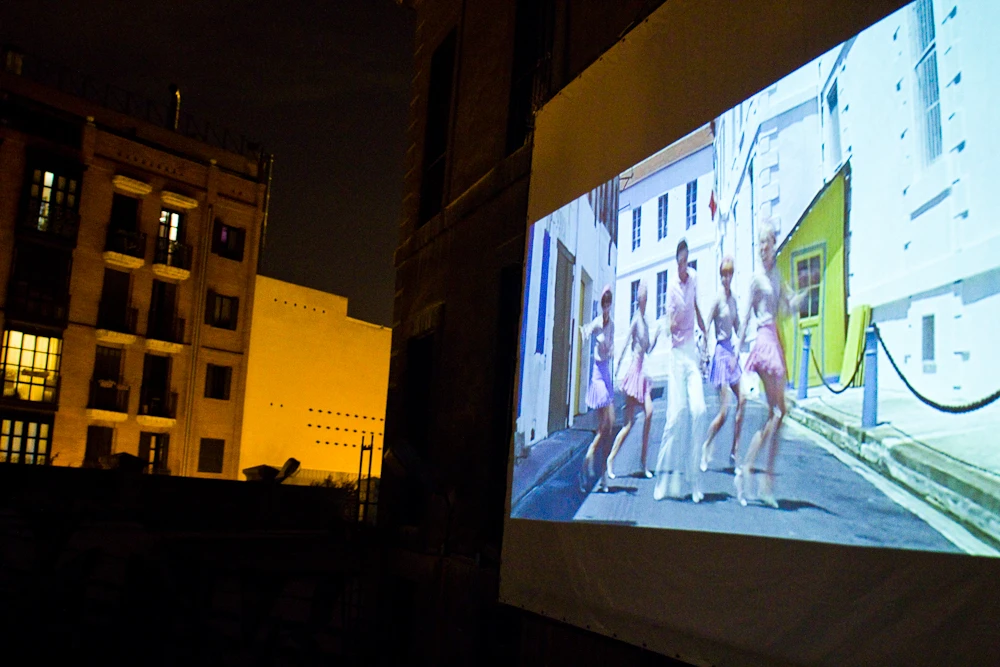
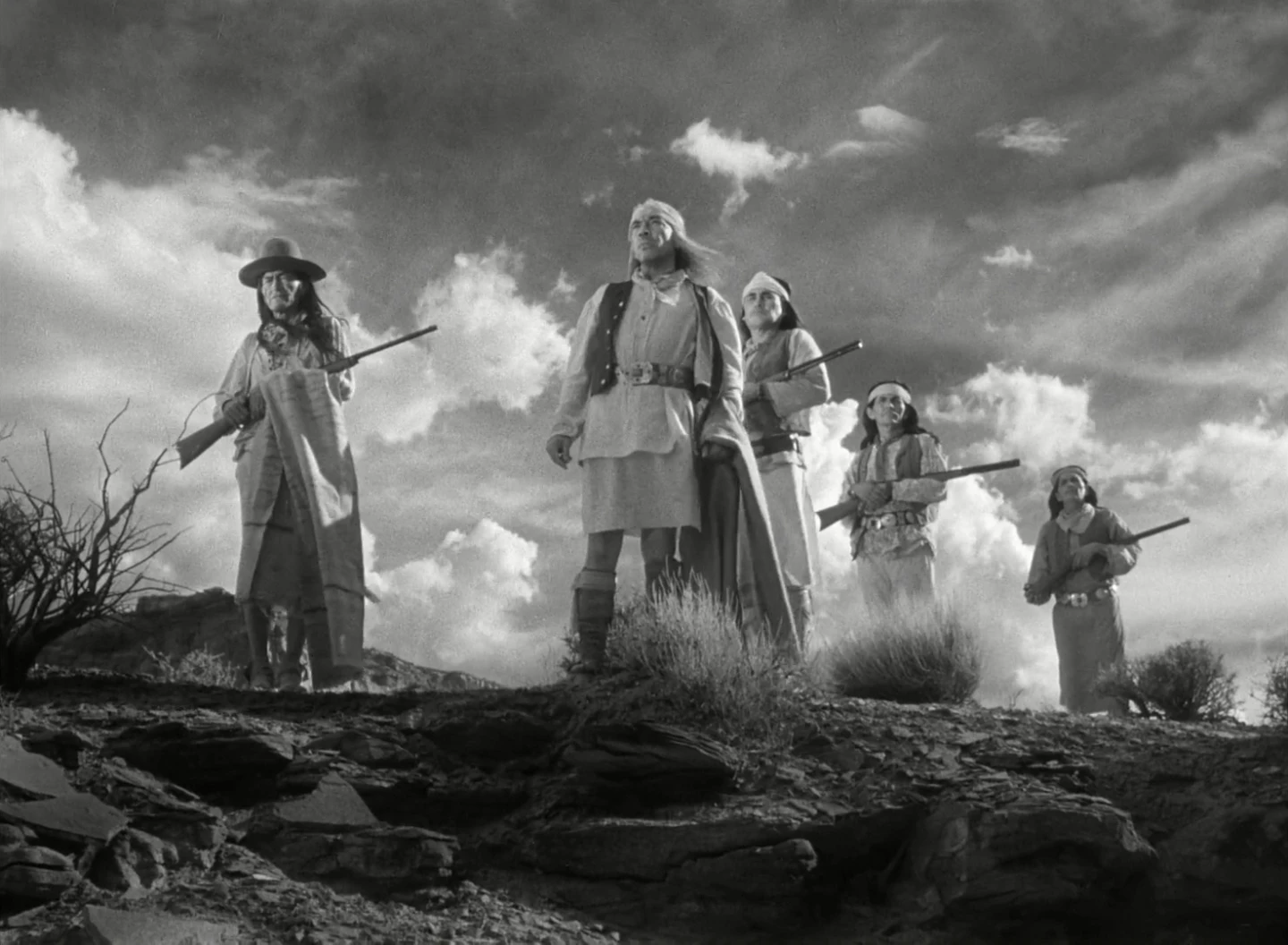
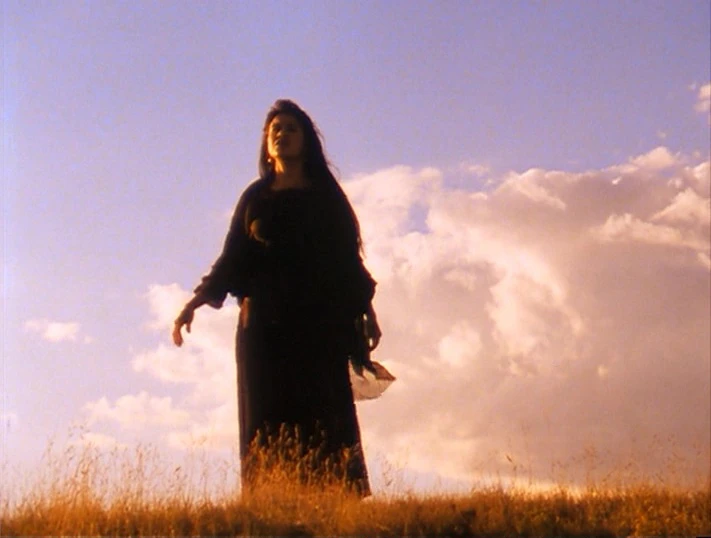
Actividad dentro de la programación...
Cinema Commons
Cinema Commons is a research, programming and publishing project which explores how film and sound experiences articulate interpretive communities, fostering collective debate and devising proposals for common spaces. Constructed in two annual editions, this year it will explore three core strands: the alternative film society as a place of utopia and resistance, with film curators Miriam Martín and Ana Useros; the work of artist Christian Nyampeta and the École du soir, a learning collective focused on African diaspora and inspired by the trailblazing Senegalese film-maker Ousmane Sembène; and the union between activism and celluloid, machine and poetry, in the L’Abominable Laboratory, located on the outskirts of Paris.
The project addresses processes of socialisation and film’s potential beyond the image, with this edition bringing together different practices which explore film’s capacity to assemble and produce common spaces, understood in architectural, social and political terms. Film has always been a decisive tool in struggles for emancipation and, setting out from this genealogy, the proposals in this edition look to understand the role it can play in today’s cultural and political context, overcoming the dominant forms of representation and its modes of distribution to advance towards an ethics of life in common.
Ver programaMás actividades

CLINIC 2628. A Community of Writing and Research in the Arts
February – October 2026
Clinic 2628 is a project which supports and brings together writings which stem from the intention to offer a space and sustainable time for research work in art and culture. Framed within an academic context which is increasingly less receptive to the forms in which thinking happens and is expressed, the aim is to rescue the academic from its neoliberal trappings and thus recover the alliance between precision and intuition, work and desire. A further goal is to return writing to a commons which makes this possible through the monitoring of processes and the collectivisation of ideas, stances, references and strategies.
The endeavour, rooted in a collaboration between the Museo Reina Sofía’s Studies Directorship and the Artea research group, via the i+D Experimenta project, is shaped by three annual editions conceived as spaces of experimentation, discussion and a demonstration of writings critical of what is put forward by today’s academia.
What forces, forms and processes are at play when writing about art and aesthetics? In academia, in museums and in other cultural institutions, the practice of writing is traversed by productivist logics which jeopardise rhythms of research and experimentation. The imposition of both scientism inherent in the structure of “the paper” and the quantifying of results which demand a criterion of quality and visibility sterilise and smoothen, from the outset, the coarseness that is particular to writing understood from the concrete part of language: phonic, graphic, syntactic and grammatical resistance connecting the language user to the community the language unites and activates. They also sterilise the roughness enmeshed in the same desire to write, the intuitive, clear and confusing pathways that once again connect the writer to those reading and writing, participating in a common good that is at once discovered and produced.
The progressive commercialisation of knowledge propelled by cognitive capitalism moves further away from the research and production of knowledge in artworks and artistic languages and practices. The work of curators and archive, criticism, performances and essays formerly saw a horizon of formal and emotional possibilities, of imagination that was much broader when not developed in circumstances of competition, indexing and impact. Today, would it be possible to regain, critically not nostalgically, these ways; namely, recovering by forms, and by written forms, the proximity between art thinking and its objects? How to write in another way, to another rhythm, with no more demands than those with which an artwork moves towards different ways of seeing, reading and being in the world?

The (legal) person and the legal form. Chapter II
8, 12, 15 January, 2026 – 16:00 to 19:00
As part of the Studies Constellation, the Study Directoship’s annual fellowship, art historian and theorist Sven Lütticken leads the seminar The (Legal) Person and the Legal Form: Theoretical, Artistic, and Activist Commitments to foster dialogue and deepen the hypotheses and questions driving his research project.
This project, titled Unacting Personhood, Deforming Legal Abstraction, explores the dominance of real abstractions—such as exchange value and legal form—over our processes of subjectivation, and asks how artistic practices can open up alternative ways of representing or performing the subject and their legal condition in the contemporary world.
The seminar consists of eight sessions, divided into three chapters throughout the academic year. While conceived as non-public spaces for discussion and collective work, these sessions complement, nourish, and amplify the public program of the Studies Constellation.
In this second chapter of the seminar, the inquiry into the aesthetics and politics of legal form continues with three sessions that pick up the discussions held in Chapter I but propose new lines of flight. The first session focuses on international law via the writings of the British author China Miéville, which allows us to reconsider the notion of the legal form –following Evgeny Pashukanis— and, through it, a variety of (people’s) tribunals. While the crucial concept of the legal person –as the right-holder central to the form of law— was debated in Chapter I, the second session focuses on attempts to extend personhood not (just) to corporations, but rather to nonhuman animals or ecosystems. Finally, the third session poses the question: how can groups and networks use officially recognized organizational forms (such as the foundation or the cooperative) and/or use a collective persona (without necessarily a legal “infrastructure” to match) to act and represent themselves?

Oliver Laxe. HU/هُوَ. Dance as if no one were watching you
Tuesday, 16 December 2025 – 7pm
As a preamble to the opening of the exhibition HU/هُوَ. Dance as if no one were watching you, film-maker Oliver Laxe (Paris, 1982) engages in conversation with the show’s curators, Julia Morandeira and Chema González, touching on the working processes and visual references that articulate this site-specific project for the Museo Reina Sofía. The installation unveils a new programme in Space 1, devoted from this point on to projects by artists and film-makers who conduct investigations into the moving image, sound and other mediums in their exhibition forms.
Oliver Laxe’s film-making is situated in a resilient, cross-border territory, where the material and the political live side by side. In HU/هُوَ. Dance as if no one were watching you, this drift is sculpted into a search for the transcendency that arises between dancing bodies, sacred architectures and landscapes subjected to elemental and cosmological forces. As a result, this conversation seeks to explore the relationship the piece bears to the imagery of ancient monotheisms, the resonance of Persian Sufi literature and the role of abstraction as a resistance to literal meaning, as well as looking to analyse the possibilities of the image and the role of music — made here in collaboration with musician David Letellier, who also works under the pseudonym Kangding Ray — in this project.
These inaugural conversations, part of the main working strands of the Museo’s Public Programmes Area, aim to explore in greater depth the exhibition narratives of the shows organised by the Museo from the perspective of artists, curators and specialists.
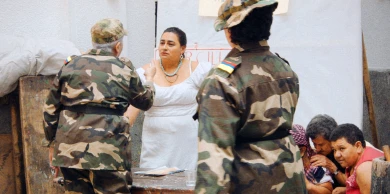
Manuel Correa. The Shape of Now
13 DIC 2025
The Shape of Now is a documentary that explores the challenges and paradoxes of memory, reparation and post-conflict justice, extending a defiant and questioning gaze towards the six-decade armed conflict in which the Colombian State, guerrillas and paramilitary groups clashed to leave millions of victims in the country. The screening is conducted by the Aesthetics of Peace and Desertion Tactics study group and includes a presentation by and discussion with the film’s director, Manuel Correa.
The film surveys the consequences of the peace agreements signed in 2016 between the Colombian State and the FARC guerrilla organisation through the optics of different victims. It was recorded shortly after this signing, a time in which doubts lingered over the country’s future, with many groups speculating in the narration. Correa harnesses the power of images, visual and bodily memory, fiction and re-staging as tools for understanding the conflict, memory and healing, as well as for the achievement of a just peace that acknowledges and remembers all victims.
The activity is framed inside the research propelled by Aesthetics of Peace and Desertion Tactics, a study group developed by the Museo’s Study Directorship and Study Centre. This annual group seeks to rethink, from a theoretical-critical and historical-artistic perspective, the complex framework of concepts and exercises which operate under the notion of pacifism. A term that calls on not only myriad practices ranging from anti-militarism and anti-war movements to activism for non-violence, but also opens topical debates around violence, justice, reparation and desertion.
Framed in this context, the screening seeks to reflect on propositions of transitional and anti-punitive justice, and on an overlapping with artistic and audiovisual practices, particularly in conflicts that have engendered serious human rights violations. In such conflicts, the role played by audiovisual productions encompasses numerous challenges and ethical, aesthetic and political debates, among them those related to the limits of representation, the issue of revictimisation and the risks involved in the artistic commitment to justice. These themes will be addressed in a discussion held after the session.
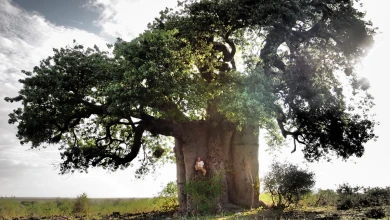
Francisco López and Barbara Ellison
Thursday, 11 December - 8pm
The third session in the series brings together two international reference points in sound art in one evening — two independent performances which converse through their proximity here. Barbara Ellison opens proceedings with a piece centred on the perceptively ambiguous and the ghostly, where voices, sounds and materials become spectral manifestations.
This is followed by Francisco López, an internationally renowned Spanish sound artist, who presents one of his radical immersions in deep listening, with his work an invitation to submerge oneself in sound matter as a transformative experience.
This double session sets forth an encounter between two artists who, from different perspectives, share the same search: to open ears to territories where sound becomes a poetic force and space of resistance.
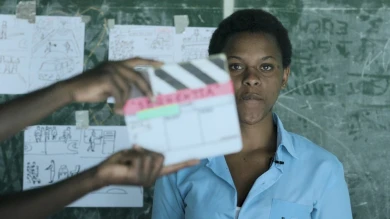



![Miguel Brieva, ilustración de la novela infantil Manuela y los Cakirukos (Reservoir Books, 2022) [izquierda] y Cibeles no conduzcas, 2023 [derecha]. Cortesía del artista](https://recursos.museoreinasofia.es/styles/small_landscape/public/Actividades/ecologias_del_deseo_utopico.jpg.webp)
![Ángel Alonso, Charbon [Carbón], 1964. Museo Reina Sofía](https://recursos.museoreinasofia.es/styles/small_landscape/public/Actividades/perspectivas_ecoambientales.jpg.webp)